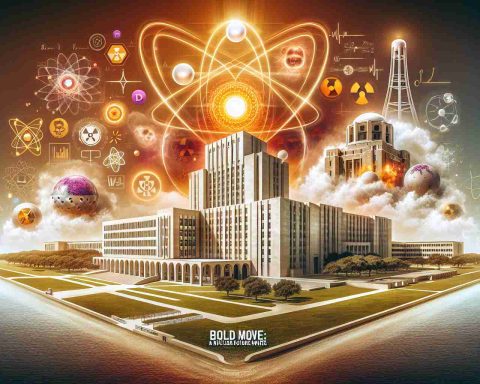- Arizona’s leading utilities are looking to build new nuclear power plants to meet increasing energy demands.
- Major players in this initiative include Arizona Public Service, Salt River Project, and Tucson Electric Power.
- They seek support from the U.S. Department of Energy for the exploration of potential sites.
- The site selection process is expected to take around three years, with possible implementation in 15 years.
- Nuclear energy is seen as vital for a diversified, reliable, and cost-effective energy strategy.
- Arizona currently hosts the second-largest nuclear plant in the U.S., signaling a strong foundation for future endeavors.
- Utilities stress the urgency of investing in sustainable energy solutions for Arizona’s future.
In a bold move to meet rising energy demands, Arizona’s leading electric utility companies are eyeing the construction of new nuclear power plants. Arizona Public Service (APS), along with Salt River Project (SRP) and Tucson Electric Power (TEP), is spearheading this initiative, seeking the backing of the U.S. Department of Energy for a promising exploration venture.
Imagine a future where clean, reliable energy flows into homes around the clock. If approved, this joint effort could pave the way for assessing numerous potential sites for nuclear facilities, including the transformation of outdated coal plants into cutting-edge power sources. The meticulous site selection process is anticipated to take approximately three years, with the dream of nuclear energy revitalizing Arizona’s power grid potentially realized within the next 15 years.
With energy consumption soaring, APS President described nuclear energy as “a cornerstone” of a diversified energy strategy—essential for ensuring a dependable and budget-friendly electric supply. Presently, Arizona is already home to the nation’s second-largest nuclear plant, the Palo Verde Nuclear Generating Station, providing a solid foundation for the state’s ambitious plans.
As the clock ticks, Arizona’s utilities emphasize one clear message: now is the time to invest in tomorrow’s energy solutions. Partnering together, they are committed to exploring all options to secure a sustainable energy future for the Grand Canyon State. Stay tuned, as Arizona may soon redefine its energy landscape!
Arizona’s Nuclear Future: What You Need to Know!
Overview of Arizona’s Nuclear Power Initiative
In a significant shift towards sustainable energy, Arizona’s leading utility companies, including Arizona Public Service (APS), Salt River Project (SRP), and Tucson Electric Power (TEP), are actively pursuing the development of new nuclear power plants. This initiative aligns with national energy strategies aimed at addressing growing energy demands while minimizing environmental impact. The utilities have reached out to the U.S. Department of Energy for support as they embark on this ambitious journey.
This move seeks not just to maintain but to enhance the state’s energy capacity through modern nuclear technology, possibly transforming outdated coal plants into state-of-the-art facilities. The next steps involve a thorough site selection process, estimated to last about three years, aimed at identifying suitable locations for the new plants.
Key Trends and Insights
1. Growing Energy Consumption: Acknowledging rising energy demands, the utilities view nuclear energy as essential to diversify the state’s energy mix, increasing reliability and affordability.
2. Nuclear Energy as a Cornerstone: APS emphasizes that nuclear power is integral to achieving a consistent and budget-friendly electric supply, marking a shift towards sustainable energy practices.
3. Long-Term Vision: If all goes well, nuclear facilities could start coming online in approximately 15 years, marking a transformative phase in Arizona’s energy landscape.
Advantages of Nuclear Energy
– Clean Energy Generation: Nuclear power produces minimal greenhouse gas emissions, aligning with sustainability goals.
– Base Load Power Source: Unlike solar and wind, nuclear energy provides consistent energy output, crucial for meeting base load needs.
– Economic Growth: The construction and operation of new nuclear plants can create jobs and stimulate the local economy.
Limitations and Challenges
– Public Perception and Safety: Concerns about nuclear safety and waste disposal remain critical hurdles to broader acceptance.
– Regulatory Hurdles: Securing all necessary approvals from federal and state authorities could delay projects.
– Initial Costs: High upfront capital investment may be a barrier to quick expansion.
Market Forecasts and Predictions
Experts predict that as technology advances, the integration of small modular reactors (SMRs) could provide a cost-effective and flexible approach to expand nuclear capacity in a shorter timeframe. Moreover, growing commitments to reduce carbon emissions at both local and national levels are likely to further bolster nuclear energy’s role in Arizona’s energy policy.
FAQs
1. What will happen to existing coal plants in Arizona?
The initiative involves the potential transformation of outdated coal plants into modern nuclear facilities, promoting a shift to cleaner energy sources while reducing reliance on fossil fuels.
2. How much time is needed before new nuclear plants become operational?
The site selection and approval process is projected to take around three years, with a goal of having new nuclear energy operational in 15 years.
3. What are the anticipated economic impacts of building new nuclear plants?
The construction and operation of new nuclear facilities are expected to create thousands of jobs and foster economic development in the region, providing long-term economic benefits.
For more information on Arizona’s energy initiatives, visit APS.
The source of the article is from the blog qhubo.com.ni














